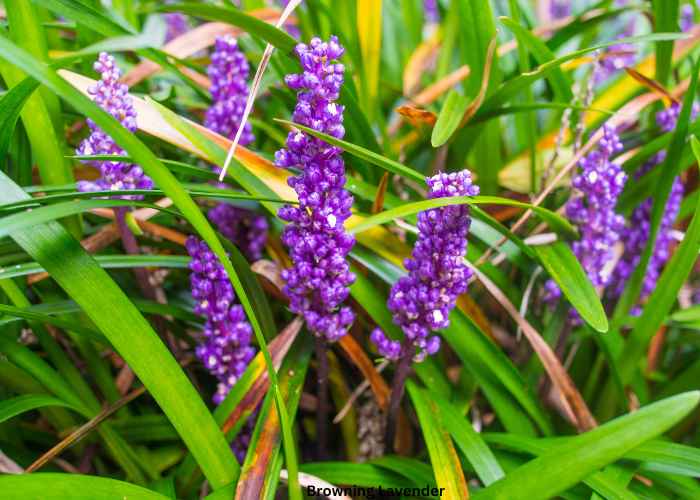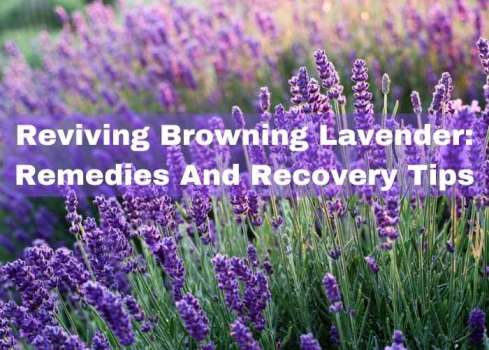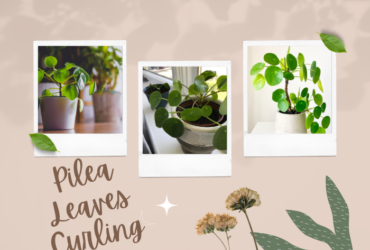Why is my lavender dying?
The reason behind your lavender turning brown and dying is the fungal disease root rot. This happens because the irrigation is too frequent. You are watering the plant more than needed, or are watering before the soil dries.
When the soil is humid more than the plant needs, the stem of the lavender starts turning brown and the plant gives a wilting appearance.
So, what to do when lavender turns brown? Well, you should stop overwatering the plant.
In this blog, I’ll be covering the tips and remedies to revive your browning lavender. Let’s begin with an overview of this gorgeous lavender plant.
Lavender Plant- Overview
Lavender is a herb that makes a stunning addition to the gardens and has versatile uses. It blooms during mid to late summers and adds colours to the borders of the garden. With the grey-green foliage and upright flower spikes, it is an ideal choice for creating informal hedges.
Although lavender is native to the Mediterranean, there are many varieties that grow and bloom in different weather conditions around the world.
Do you know? Despite of its name ‘lavender’, not all lavenders are purple in color. A few varieties are found in pastel hues including pale pink, violet blue and more.
Growing lavender is not difficult at all and is worth it. The only thing that you should look for is well-drained soil and a spot that receives good sunlight during the day.
Why Is My Lavender Dying?

A lot of gardeners complain that their lavender plants turned grey. This happens because of one of the following reasons:
- Soil that does not drain
- High humidity
- Overwatering the lavender
- High rainfall
- Under or over-nutrient soil
- Weather conditions (seasonal)
So, can you revive the browning lavender? Yes, you can.
Here are the remedies to rescue your dying lavender.
6 Remedies To Revive The Browning Lavender
Let’s take a look at the solutions of the above potential reasons for your lavender.
Soil Drainage Problem
Lavender plants do not require high maintenance because they are adapted to be grown in dry areas with minimum care. But you might have grown it in heavy soil that is not porous.
Heavy soil such as clay holds the moisture for longer and does not let the stem dry. This becomes the reason behind lavender turning brown.
The second reason can be that the soil in which you planted lavender was full of organic matter such as compost mix. It also prevents the moisture from draining quickly and causes the lavender to turn brown.
The solution to the above problems can be:
- Adjust the soil by mixing a portion of sand to make it porous.
- Transfer the lavender from the soil to the pot so that water can be drained easily.
Here are the steps to adjust the heavy soil to make it porous:
Step 1: Lift the lavender from the ground using a fork, and place it aside.
Step 2: Now, dig the soil of up to 18 to 20 inches, and as much deep as you can.
Step 3: Divide this heavy soil into three parts. Take one part add 1 part of the organic compost, and one part of sand. Mix it all and fill the space. Distribute the 2/3rd part of the heavy soil elsewhere in the garden.
Step 4: Replant the lavender and do not water for a few days.
Another solution is to transfer the plant to the pot that drains water properly. Lavenders grow happily in the pots, and pots’ soil is easy to adjust if it does not drain itself.
You can prepare the soil mix the same as for the ground, and fork and transfer the browning lavender into the pot.
Leave the pot for about 2 weeks to dry. Then water every two weeks to revive it.
Make sure the pot is undercover and does not get direct rainwater.
Remember: Lavenders that have turned brown do not always recover and change to green at foliage. But transplanting them to the right porous soil is the best thing you can do for them.
High Humidity Problem

There are species of lavender that survive in cold climates and do not get root rot. However persistent exposure to high humidity can cause the lavender to turn brown.
Also, lavender grows best when planted at 2 to 3 feet apart from each other and from other plants. This is essential so that airflow is normal for the foliage.
Tip: You can ensure the airflow by keeping the surrounding area of lavender plants clean. Pick up the dry leaves regularly to avoid blockage.
Overwatering The Lavender Problem
Behind the majority of the browning lavender lies the problem of overwatering it. When you water the lavender frequently, it becomes susceptible to getting root rot.
As mentioned earlier, lavender plants are native to dry regions where there is very low annual rainfall with high temperatures.
To avoid root rot due to overwatering, prefer:
- Watering the lavender once every two weeks. You can also skip this if there’s rain in your area.
- When you transplanted the browning lavender, make sure to water it once every 3 days to mitigate the transplant shock.
- Avoid watering the lavender during winter because there is a high chance that it will get root rot during that season.
Tip: The best time to transplant the lavender is spring season. But if you observe that the lavender plant is brown, you can transplant it regardless of the time of the year.
High Rainfall Problem
Another cause behind browning lavender can be high rainfall in your area. If this is the case with you, avoid watering the lavender during the rainfall seasons, because the plant accumulates enough moisture from the environment.
You can prevent root rot due to rainfall by:
- Adjusting the soil by adding sand to the heavy soil.
- Cover lavender plants from rain.
To adjust the soil, you can mix 50% soil with the remaining part of the organic compost. This mixture is essential for producing flowers with your lavender in the areas of high rainfall.
Alternatively, you can transplant the lavender plants from the ground to the pots. This is more convenient because you would be able to move the pots under the shelter during heavy rainfall season.
Don’t forget to move the pots in the full sun when the sun is out.
Under Or Over Nutrition Causes Lavender To Turn Brown
Lavender can also turn brown when they are grown in less nutritious soil. Or you are not fertilizing the plant as per its needs.
If the reason behind your browning lavender is not overwatering, then you should consider looking at the frequency at which you fertilize the plant’s soil.
To avoid this problem, fertilize the lavender at least twice a year.
Weather Conditions (Seasonality) Causes Lavender To Turn Brown
As lavender blooms during the summer season, it is common for the plant foliage to turn brown during the winter season.
So, if your plant is turning brown during the winter or fall season, there is no need to worry, as it is preparing itself for a dormant period.
Browning lavender based on season depends on where you live (climate conditions). Especially, if the flowers of the plant are turning brown, there’s nothing to worry about.
Other Reasons Behind Lavender Turning Brown
In addition to the above-mentioned 6 common problems with lavender plants, there can be other reasons behind lavender turning brown. This may happen because of
- Disease (you can observe the plant leaves if they have pores on them)
- Pests (if you observe small insects on the foliage of the lavender plant, you should treat your plant with insecticide as soon as possible).
- Browning of the lavender can also occur due to missing pruning. Remember to prune the plants after a while to help the healthy plant growth.
Key Takeaways
- There can be multiple reasons behind browning lavender, a few of them include poor draining soil, high humidity, heavy rainfalls, overwatering, less nutritious soil, and seasonality.
- You can avoid the lavender from turning brown by adjusting the soil (mix sand if it was heavy soil before).
- Or you can also transplant it in the pots as pots are convenient to take under the shelter.
- Make sure to clean up the space around the lavender plants regularly.
- Plant new lavender plants at least 2 feet away from each other and other plants.
- Lavender naturally grows in dry weather conditions, so avoid watering them during the winter season.
Frequently Asked Questions
Here are the most frequently asked questions related to lavender plant care.
What to do when lavender turns brown?
You can check how frequently you are watering the lavender, or fertilzing it. Stop overwatering it because this is the reason behind majority of the browning lavender plants.
How to tell if lavender is overwatered?
The plant’s foliage will start turning brown and it will appear wilting.
How long do lavender plants last?
If the plants are properly maintained and taken care of, lavender plants last for 10 to 15 years.














Leave a Reply